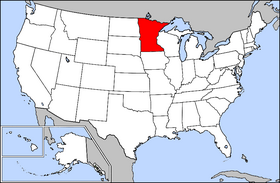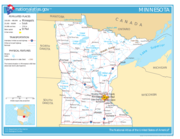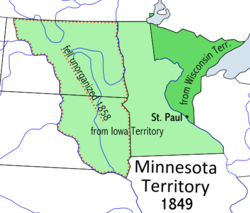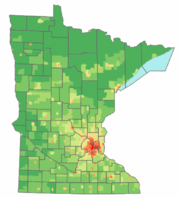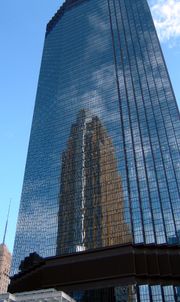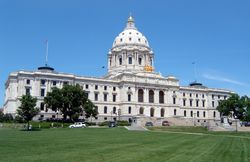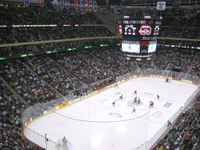Minnesota
2007 Schools Wikipedia Selection. Related subjects: North American Geography
|
|||||||||||
| Capital | Saint Paul | ||||||||||
| Largest city | Minneapolis | ||||||||||
| Area | Ranked 12th | ||||||||||
| - Total | 87,014 sq mi (225,365 km²) |
||||||||||
| - Width | 250 miles (400 km) | ||||||||||
| - Length | 400 miles (645 km) | ||||||||||
| - % water | 8.4 | ||||||||||
| - Latitude | 43°34'N to 49°23'50.26"N | ||||||||||
| - Longitude | 89°34'W to 97°12'W | ||||||||||
| Population | Ranked 21st | ||||||||||
| - Total ( 2000) | 4,919,479 | ||||||||||
| - Density | 61.80/sq mi 23.86/km² (31st) |
||||||||||
| - Median income | $55,914 (5th) | ||||||||||
| Elevation | |||||||||||
| - Highest point | Eagle Mountain 2,301 ft (701 m) |
||||||||||
| - Mean | 1,198 ft (365 m) | ||||||||||
| - Lowest point | Lake Superior 602 ft (183 m) |
||||||||||
| Admission to Union | May 11, 1858 (32nd) | ||||||||||
| Governor | Tim Pawlenty ( R) | ||||||||||
| U.S. Senators | Mark Dayton ( D) Norm Coleman ( R) |
||||||||||
| Time zone | Central: UTC-6/ -5 | ||||||||||
| Abbreviations | MN US-MN | ||||||||||
| Web site | www.state.mn.us | ||||||||||
Minnesota ( IPA: [ˌmɪnəˈsoʊtə]) ( Audio (US) ) is a state in the Midwestern region of the United States. It is the 12th largest state in the U.S., and the 21st most populous, with over five million residents. Minnesota was carved out of the eastern half of the Minnesota Territory and admitted to the Union as the 32nd state in 1858. While the state's residents have been primarily white, Northern European, and Lutheran, substantial influxes of African, Asian, and Hispanic immigrants have joined the descendants of European immigrants and Native American descendants of its original inhabitants.
Nearly three out of five Minnesota residents live in the Twin Cities metropolitan area, which is the centre of transportation, business, and industry, and home to an internationally known arts community. The remainder of the state, often referred to as Greater Minnesota, consists of western prairies now given over to intensive agriculture; eastern deciduous forests, also heavily farmed and settled; and the less-populated northern boreal forest. The state is known as the "Land of 10,000 Lakes", and those lakes and the other waters for which the state is named, together with state and national forests and parks, offer residents and tourists a vigorous outdoor lifestyle.
The extremes of the climate contrast with the moderation of Minnesota’s people. The state is known for its moderate-to-progressive politics and social policies, its civic involvement, and high voter turnout. It ranks among the healthiest states by a number of measures, and has one of the most highly educated and literate populations.
Origin of the name
The word Minnesota comes from the Dakota name for the Minnesota River, mnisota. Mni (sometimes mini, or minne) can be translated as "water". Mnisota is then translated as sky-tinted water or somewhat clouded water. Native Americans demonstrated the name to early settlers by dropping milk into water and calling it mnisota. The names of many locations in the state contain the Dakota word for water, such as Minnehaha Falls ("waterfall", not "laughing waters" as is commonly thought), Minneiska ("white water"), Minnetonka ("big water"), Minnetrista ("crooked water"), and Minneapolis, which is a combination of mni and polis, the Greek word for "city".
Geography
Minnesota is the northernmost state except for Alaska; its Northwest Angle is the only part of the 48 contiguous states lying north of the 49th Parallel. Minnesota is in the U.S. region known as the Upper Midwest. The state shares a Lake Superior water border with Michigan on the northeast; the remainder of the eastern border is with Wisconsin. Iowa is to the south, North Dakota and South Dakota are west, and the Canadian provinces of Ontario and Manitoba are north. With 87,014 square miles (225,365 km²), or approximately 2.25% of the United States, Minnesota is the 12th largest state, and is the second-largest of the Midwestern states.
Geology and terrain
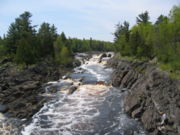
2.7 billion years ago, the first pieces of volcanic rock that would form the land of Minnesota began to rise out of an ancient ocean. Today, this rock forms the Canadian Shield. Following a period of volcanism 1.1 billion years ago, Minnesota's geological activity has been relatively quiet. During this quiet period there has been no volcanism, no new mountains have formed, and there has been little earthquake activity. In the intervening millennia Precambrian seas and recent periods of glaciation have taken once mountainous Minnesota and flattened it out. The roots of these mountains with the action of the seas formed the Iron Range of northern Minnesota. Massive glaciers at least 1,000 meters thick have ravaged the landscape beginning 600,000 years ago. The last of the four major glaciations, the Wisconsin glaciation left Minnesota 12,000 years ago. The extent of these glaciers reached all of Minnesota except the far southeast and southwest portions. The southeastern area is known as the Driftless Zone. It is characterized by low rolling hills and streams that cut into the bedrock. The glaciers left their remains across the whole state with most areas having 15 meters or more of glacial till. As the last glaciers retreated, gigantic Lake Agassiz formed in northwest Minnesota; its outflow carved the valley of the Minnesota River and its lake-bottom created the fertile lands of the Red River valley.

The action of a billion years of glaciations and erosion have left Minnesota a relatively flat state. The state's high point is Eagle Mountain at 2,301 ft (701 m), only 13 miles from the low of 602 ft (183 m) at the shore of Lake Superior. Two continental divides meet in the northeastern part of Minnesota, creating three watersheds. Rain falling in the state can follow the Mississippi River south to the Gulf of Mexico, the St. Lawrence Seaway east to the Atlantic Ocean, or the Hudson Bay watershed to the Arctic Ocean.
The state's nickname, The Land of 10,000 Lakes, is no exaggeration, as there are 11,842 lakes over 10 acres in size. The Minnesota portion of Lake Superior is the largest (962,700 acres) and deepest (1,290 feet) body of water in the state. Minnesota has 6,564 natural rivers and streams that traverse a total of 69,000 miles. The Mississippi River begins a 680 mile journey through Minnesota from its headwaters at Lake Itasca. It is joined at Fort Snelling by the Minnesota River, and in the southeast by many trout streams. The Red River, in the bed of glacial Lake Agassiz, drains the northwest part of the state northward toward Canada's Hudson Bay.
Flora and fauna
Three of the biomes of North America converge in Minnesota: the Great Plains of the west, the Big Woods deciduous forest of the southeast, and the Northern Boreal forest of the Canadian Shield. The northern coniferous forests are a vast wilderness of pine and spruce forests mixed with patchy stands of birch and poplar. Much of Minnesota's northern forest was logged, leaving only a few patches of old growth forest today such as in the Chippewa National Forest and the Boundary Waters Canoe Area Wilderness, but regrowth keeps about one third of the state forested, though logging continues. While loss of habitat has created troubles for native animals such as the pine marten, elk, buffalo, cougar, woodland caribou, and bobcat, the state contains the nation's largest population of timber wolves outside Alaska and supports healthy populations of black bear, moose and whitetail deer. Located on the Mississippi Flyway, the state hosts migratory waterfowl such as geese and ducks, as well as game birds such as grouse, pheasants, and turkeys. The state also has bird of prey species including the bald eagle, red-tailed hawk, and snowy owl. Minnesota's lakes teem with the sport fish of the region including walleye, bass, muskellunge, and northern pike. The streams in the southeast are populated with brook trout, brown trout, and rainbow trout.
Climate
Minnesota endures temperature extremes characteristic of its continental climate; with cold winters and hot summers, together the record high and low span 174 degrees. Meteorological events include rain, snow, hail, blizzards, polar fronts, tornadoes, thunderstorms, and high-velocity straight-line winds. The growing season varies from 90 days per year in the Iron Range to 160 days in southeast Minnesota near the Mississippi River, and mean average temperatures range from 36oF to 49oF. Dewpoints range from about 6oF to 70oF. Annual average precipitation ranges from 19 inches to 35 inches, and droughts occur every 10 to 50 years, depending on location.
Protected lands

Minnesota is home to a wide variety of public open space and park lands. Minnesota's first state park, Itasca State Park, which is the official source of the Mississippi River, was established in 1891. Today Minnesota has 71 State Parks. The state has two national forests, the Chippewa National Forest and the Superior National Forest. Inside of the Superior National Forest on the northeastern border of the state, lies the Boundary Waters Canoe Area Wilderness, which encompasses over a million acres and 1000 lakes. The state also has 53 state forests and numerous other wildlife preserves and regional parks. The Minnesota Department of Natural Resources is in charge of managing state parks and forests.
History
Before European settlement, Minnesota was populated by the Anishinaabe, the Sioux, and other Native Americans. European presence began with the arrival of French fur traders in the 1600s. During this century, the Ojibwe Indians migrated westward to Minnesota, and this caused tensions with the Sioux. Explorers such as Daniel Greysolon, Sieur du Lhut, Father Louis Hennepin, Jonathan Carver, Henry Schoolcraft, and Joseph Nicollet, among others, mapped out the state.
In 1805, Zebulon Pike acquired land at the confluence of the Minnesota and Mississippi rivers. This was followed by the construction of Fort Snelling between 1819 and 1825.
The soldiers built a grist mill and a sawmill at Saint Anthony Falls, and as industry later sprung up around the falls, the city of Minneapolis grew up around it. Meanwhile, squatters, government officials, and tourists had settled in the vicinity of the fort. In 1839, the Army forced them to move downriver, and they settled in an area that became St. Paul. Minnesota Territory was formed on March 3, 1849. By 1858, thousands of people had come to build farms and cut timber, and Minnesota became the 32nd U.S. state on May 11, 1858.
Treaties with the Sioux and Ojibwe gradually forced them off their land and onto smaller reservations. As conditions became less favorable for the Sioux, tensions rose, and the Sioux Uprising of 1862 resulted. The result of the six-week war was the execution of 38 Indians, the largest mass execution in United States history, and the exile of most of the rest of the Sioux to the Crow Creek Reservation in Nebraska.
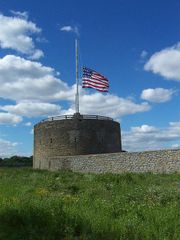
The early economy of Minnesota was based on logging and farming. The sawmills at Saint Anthony Falls, as well as logging centers like Marine on St. Croix, Stillwater, and Winona processed a large amount of lumber. These cities were well-situated on rivers that were ideal for transportation. Later, Saint Anthony Falls was tapped to provide power for flour mills. Innovations by Minneapolis millers led to the production of Minnesota "patent" flour, widely regarded as the finest bread flour of its time. By 1900, Minnesota mills, led by Pillsbury and the Washburn-Crosby Company (a forerunner of General Mills), were grinding 14.1% of the nation's grain.
Minnesota became established as an iron mining state with the discovery of iron in the Vermilion Range and the Mesabi Range in the 1880s, followed by the discovery of iron in the Cuyuna Range in the early 1900s. The iron was shipped by rail to Two Harbors and Duluth, then loaded onto ships and transported eastward through the Great Lakes.
As a result of industrial development and the rise of manufacturing, the population gradually shifted from rural areas to cities during the early 1900s. Nevertheless, farming remained prevalent throughout the state. During the years of the Great Depression, the Minnesota economy was hit hard, resulting in lower prices paid to farmers, layoffs among iron miners, and various instances of labor unrest. Compounding the adversity, western Minnesota and the Dakotas were hit by drought from 1931 through 1935. New Deal programs provided some economic turnaround. The Civilian Conservation Corps and other programs around the state established jobs for Indians on their own reservations. The Indian Reorganization Act of 1934 provided a self-government mechanism for the Indian tribes. This had the effect of providing more of a voice within the state and promoting more respect for tribal customs, as religious ceremonies and native languages were no longer suppressed.
After World War II, the pace of industrial development quickened. Technological developments increased productivity on farms, such as automation of feedlots for hogs and cattle, machine milking at dairy farms, and raising chickens in large buildings. Planting became more specialized with hybridization of corn and wheat, and mechanical equipment such as tractors and combines became the norm. University of Minnesota professor Norman Borlaug contributed to this knowledge as part of the Green Revolution. During this time, suburban development accelerated as a result of postwar housing demand, convenient transportation, and increased mobility to more specialized jobs.
Minnesota became a centre of technology after the war. Engineering Research Associates was formed in 1946 to develop computers for the United States Navy. It later merged with Remington Rand, and then became Sperry Rand. William Norris left Sperry in 1957 to form Control Data Corporation (CDC). Cray Research was formed when Seymour Cray left CDC to form his own company. Medical device maker Medtronic also got its start in the Twin Cities in 1949.
Cities and towns
The capital city of Minnesota is Saint Paul, located in the east-central part of the state along the banks of the Mississippi River. Saint Paul is adjacent to Minnesota's largest and most populous city, Minneapolis; together they and their suburbs are known as the Twin Cities metropolitan area, the 16th largest metropolitan area in the United States and home to about 60% of the state's population as of April 1, 2005. The remainder of the state is known as Greater Minnesota or Outstate Minnesota.
Minnesota cities with estimated 2005 populations above fifty thousand are, in descending order: Minneapolis, Saint Paul, Rochester, Duluth, Bloomington, Brooklyn Park, Plymouth, Eagan, St. Cloud, Coon Rapids, Burnsville, Eden Prairie, Maple Grove, Woodbury, Blaine, Lakeville, and Minnetonka. Of these, only Rochester, Duluth, and St. Cloud are outside the Twin Cities metropolitan area.
While Minnesota's population continues to grow, most of that growth is in the urban centers. The populations of metropolitan Sherburne and Scott doubled between 1980 and 2000, while 40 of the state's 87 counties lost population over those two decades.
Demographics
Population
From less than 6,100 in 1850, the population to grew to over 1.75 million in 1900. For the next six decades the population grew 15% per decade, reaching 3.41 million in 1960. Growth thereafter slowed, rising 11% to 3.8 million in 1970, and 9% average over the next three decades to 4.91 million in the 2000 census. As of 2005 the population was estimated to be 5,132,799 by the U.S Census Bureau, and 5,205,091 by the State Demographer. The rate of increase and age and gender distributions approximate the national average, but Minnesota's minorities, although growing, form a significantly smaller proportion than in the nation as a whole. The centre of population of Minnesota is located in Hennepin County, in the city of Rogers.
Race and ancestry
Over 75% of the population is of Western European descent, with the largest reported ancestries being German (37.3%), Norwegian (17.0%), Irish (12.2%), and Swedish (10.0%). As of 2004, 6.1% of Minnesota residents were foreign-born, compared to 12% for the nation. The state had a reputation of being relatively homogeneous, but that is changing. The Hispanic population of Minnesota is increasing rapidly, and recent immigrants have come from all over the world, including Hmongs, Somalis, Vietnamese, Indians, Middle Easterners, and emigrants from the former Soviet bloc.
The racial makeup of the state as of 2005 was:
- 86.3% White (non-Hispanic)
- 4.1% Black (non-Hispanic)
- 3.6% Hispanic, a category that includes people of any race
- 3.4% Asian/Pacific Islander
- 1.1% Native American/Alaskan Native
- 1.5% Mixed Race
- 1.8% Other races
Religion
A 2001 survey shows a statewide breakdown of Roman Catholics at 25%, Lutherans at 24%, Baptists at 5%, Methodists at 4%, Assembly of God at 2%, Church of God at 2%, and Presbyterians 2%. Christians with unstated or other denominational affiliations including other Protestants total 13%, bringing the total Christian population to 77%. Non-Christian religions including Judaism, Islam, Buddhism, and Hinduism make up 3% of the population. People who answered "No religion" on the survey total 14%, and 6% refused to answer.
Economy
The state's economy has transformed in the past 200 years from one based on raw materials to one based on finished products and services. Perhaps the most significant characteristic of the economy is its diversity, which closely matches that of the nation as a whole. The economy of Minnesota produced 234 billion dollars of gross domestic product in 2005. Thirty-six companies in the top 1000 U.S. publicly-traded companies (by revenue in 2006) are headquartered in Minnesota. This includes such diverse companies as Target, UnitedHealth Group, 3M, Medtronic, General Mills, U.S. Bancorp, and Best Buy. The largest privately owned U.S. company, Cargill is also headquartered in Minnetonka. The Per capita personal income in 2004 was $36,184, 8th in the nation. The median household income in 2005 was approximately $52,024, ranking eleventh in the nation.
Industry and commerce
Minnesota's earliest industries were fur trading and agriculture; the city of Minneapolis was built around the flour mills clumped around St. Anthony Falls. Agriculture is still a major part of the economy even though only a small percentage of the population, less than 1%, are employed in the farming industry. The state is still the U.S.'s largest producer of sugar beets, sweet corn, and green peas for processing, and farm-raised turkeys. Forestry, another early industry, remains strong with logging, pulpwood processing, forest products manufacturing, and paper production. Minnesota was famous for its soft-ore iron mines which produced a significant portion of the world's iron ore for over a century. Although the high-grade ore is now depleted, taconite mining remains strong using processes developed locally to save the industry. In 2004 the state produced 75% of the usable iron ore in the country. The port of Duluth was created by the mining boom and today continues to be an important shipping port for ore, coal, and agricultural products. The manufacturing sector now includes strong technology and biomedical firms in addition to the older food processing, forestry, and heavy industries. The nation's first indoor shopping mall was Edina's Southdale Centre and its largest, the Mall of America, is located in Bloomington.
Energy use and production
Ethanol fuel is produced in the state, and a 10% mix of ethanol ( E10) has been mandated since 1997, making Minnesota the first U.S. state with such a mandate. A 20% ethanol mix (E20) will be mandated in 2013. Minnesota has nearly 300 gas stations supplying E85 fuel. A 2% biodiesel blend has also been required in diesel fuel since 2005. Electricity-producing wind turbines have become popular, particularly in the windy southwest region on the Buffalo Ridge. As of November 2006, the state is the country's fourth-largest wind energy producer, with 812 megawatts installed and an additional 82 MW planned.
State taxes
Minnesota has a slightly progressive income tax structure, with three brackets of state income tax rates, 5.35%, 7.05% and 7.85%. The sales tax in Minnesota for most items is 6.5%, however the state does not charge sales tax on clothing, prescription medications, some services, or food items for home consumption. Municipalities may be allowed by the State Legislature to institute local sales taxes and special local taxes, such as the 0.5% additional sales tax in Minneapolis. The cities of St. Paul, Rochester, Duluth and St. Cloud have similar taxes. Excise taxes are levied on alcohol, tobacco, and motor fuel. The state also imposes a use tax on items purchased elsewhere but used within Minnesota. Owners of real property in Minnesota also pay property tax to their county, municipality, school district, and special taxing districts.
Culture
Fine and performing arts
The Twin Cities area is considered the capital for the arts in the upper Midwest. Major fine art museums include the Weisman Art Museum, the Walker Art Centre, and the Minneapolis Institute of Arts. The Saint Paul Chamber Orchestra and Minnesota Orchestra are full-time professional musical ensembles providing concerts and educational programs to the community. Attendance at theatrical, musical, and comedy events across the area is strong, which may be attributed to the cold winters, the large number of colleges and universities, and a generally vibrant economy. The Guthrie Theatre boasts three separate stages in its new (2006) building overlooking the Mississippi River. In the United States, the Twin Cities rank behind only New York City in number of theater seats per capita; in 2000, 2.3 million theatre tickets were sold. The Minneapolis Fringe Festival is an annual celebration of theatre, dance, improvisation, puppetry, kids' shows, visual art, and musicals. The festival consists of over 800 performances in 11 days in the summer and is the largest non-juried performing arts festival in the United States.
Literature
The rigors and rewards of pioneer life on the prairie were the subject of Giants in the Earth by Ole Rolvaag and the Little House series of children's books by Laura Ingalls Wilder. Small town life was savaged by Sinclair Lewis in Main Street and more gently and affectionately satirized by Garrison Keillor in his tales of Lake Wobegon. St. Paul native F. Scott Fitzgerald wrote of the the social insecurities and aspirations of the young city in stories such as Winter Dreams and The Ice Palace (published in Flappers and Philosophers).
Entertainment
Minnesotan musicians from all genres have been popular over the years, producing such nationally-known acts artists as Andrews Sisters, Bob Dylan, Jimmy Jam & Terry Lewis, Prince, and Semisonic. Minnesota has also produced cult favorites The Replacements, Hüsker Dü and Atmosphere.
Minnesota and Wisconsin have also contributed significantly to comedy in its different forms. Ole and Lena jokes can't be fully appreciated unless delivered in the accent of Scandinavian-Americans. Garrison Keillor is known around the country for resurrecting the old-style radio comedy with A Prairie Home Companion which has been on the air since the 1970s. Local television had the satirical show The Bedtime Nooz in the 1960s, while area natives Lizz Winstead and Craig Kilborn helped create the increasingly influential Daily Show decades later. Joel and Ethan Coen have produced many films featuring dark comedy, and numerous others brought the offbeat cult shows Mystery Science Theatre 3000 and Let's Bowl to the national cable-waves from the Twin Cities.
Popular culture
Stereotypical Minnesotan traits include Minnesota nice, Lutheranism, a strong sense of community and shared culture, and a distinctive Upper Midwestern accent sprinkled with Scandinavian-sounding words such as uff da. Potlucks, usually with a variety of hotdish casseroles, are popular at community functions, especially for church-related activities. Minnesota's Norwegian and Scandinavian heritage makes lutefisk a traditional holiday dish. The radio show A Prairie Home Companion and the book How to Talk Minnesotan lampoon Minnesotan culture, speech and mannerisms.
The Minnesota State Fair, advertised as The Great Minnesota Get-Together, is an icon of state culture. Its 2006 attendance of nearly 1.7 million visitors, in a state of 5.1 million people, lends credence to to its significance. Although the fair covers a wide swath of genres including fine art, science, agriculture, food preparation, 4H displays, music, the midway, and corporate merchandising, the Minnesota state fair is known for the displays of seed art, butter sculptures of dairy princesses, the birthing barn, and dozens of varieties of food on a stick (such as Hot Dog on a Stick). On a smaller scale, these same attractions are offered at Minnesota's numerous county fairs.
Other large annual festivals include the Saint Paul Winter Carnival, Minneapolis' Aquatennial and Mill City Music Festival, and Detroit Lakes' 10,000 Lakes Music Festival and WE Fest.
Outdoor recreation
Fishing is popular in Minnesota; more than 36% of Minnesotans fish, which is second only to Alaska. During the winter, ice fishing is popular, as it has been since the arrival of early Scandinavian immigrants. Hunting is another common activity. Families frequently own or share cabins on central and northern tracts of land in forests and adjoining lakes, and weekend trips out to these properties are common, particularly in the summer. A concern for environmentalism is shared by most state residents in one form or another, which is sometimes attributed to the popularity of these outdoor activities.
Minnesota's 71 state parks, which protect diverse landscapes, are quite popular. As with other North Woods states (such as Wisconsin, Michigan, and Maine), residents like to joke that the mosquito is the state bird because of their high populations in these areas. In reality, Minnesota's state bird is the common loon.
Socio-economic
Education
One of the first acts of the Minnesota Legislature when it opened in 1858 was the creation of a normal school at Winona. Since then, Minnesota has remained among the ten strongest states in the United States in education in most surveys. It ranks 13th on the 2006–2007 Morgan Quitno Smartest State Award and first on the percentage of its residents with a high school diploma or higher. Minnesota ranks 5th in the nation in high school graduation, with an 84% graduation rate. While Minnesota has steered clear of movements in education such as school vouchers and the teaching of intelligent design, it is home to one of the first charter schools.
The state supports a network of public universities and colleges, currently comprised of 32 institutions in the Minnesota State Colleges and Universities System and five major campuses of University of Minnesota. The state is also home to more than 20 private colleges and universities, six of which rank in the top 100 liberal arts colleges according to U.S. News and World Report.
Health
The University of Minnesota Medical School is a highly-rated teaching institution which has made a number of significant breakthroughs in treatment, and its research activities significantly contribute to the state's growing biotechnology industry. The Mayo Clinic, a world-renowned medical practice, is based in Rochester. Mayo and the University are partners in the Minnesota Partnership for Biotechnology and Medical Genomics, a state-funded program which conducts research projects in cancer, Alzheimer’s disease, heart health, obesity, and other areas.
Minnesota ranks first in the percentage of residents engaging in regular physical exercise, and second in three crucial indices: low infant mortality, long life expectancies, and death rate per 100,000. According to the U.S. Census Bureau, 91.3% of Minnesotans have health insurance coverage, higher than any other state. These and other measures have led one group to rank Minnesota as the healthiest state in the nation, and another to rank it fourth.
Transportation
Transportation in Minnesota is overseen by the Minnesota Department of Transportation. Principal transportation corridors radiate out from the Minneapolis-St. Paul metropolitan area and Duluth. Major Interstate highways are I-35, I-90, and I-94, with I-35 and I-94 passing through the Minneapolis-St. Paul metropolitan area, and I-90 going east-west at the southern edge of the state. In 2006 a Constitutional Amendment was passed in the state, requiring sales and use taxes levied on motor vehicles to be dedicated to transportation, specifying at least 40% toward public transit. There are nearly two dozen rail corridors within the State, most of which go to or through Minneapolis-St. Paul or Duluth. There is water transportation along the Mississippi River system and from Lake Superior ports.
Minnesota's principal airport is Minneapolis-St. Paul International Airport (MSP), the headquarters and a major passenger and freight hub for Northwest Airlines, and headquarters and the major hub of Sun Country Airlines. The airport also is served by most other domestic carriers. Large commercial jet service is also provided at Duluth and Rochester, with scheduled commuter service to six smaller cities via Eagan-based Mesaba Airlines.
Amtrak's Empire Builder runs through Minnesota, making stops at Midway Station in St. Paul and five other stations. Intercity bus service is provided by Greyhound, Jefferson Lines, and Coach USA.
Public transit in Minnesota is currently limited to bus systems in the larger cities and the Hiawatha Line light rail corridor in the Minneapolis-St. Paul area.
Law and government
As in the federal government of the United States, power in Minnesota is divided into three branches: Executive, Legislative, and Judicial.
Executive
The executive branch is headed by the governor, currently Tim Pawlenty, a Republican, whose 1st term began 6 January 2003, and who was narrowly re-elected in 2006. The current lieutenant governor of Minnesota is Carol Molnau. Molnau also currently serves as the head of the Minnesota Department of Transportation. The offices of governor and lieutenant governor have four-year terms. The governor has a cabinet consisting of the leaders of various government agencies in the state, called commissioners. The other constitutional offices are secretary of state, attorney general and state auditor.
Legislative
The Minnesota Legislature is a bicameral body consisting of the Senate and the House of Representatives. The state has 67 districts, each covering about 60,000 people. Each district has one senator and two representatives (each district being divided into A and B sections). Senators serve for four years and representatives for two years. In the November 2006 election, the Democratic-Farmer-Labor Party gained 19 house seats, giving them control of the Minnesota House of Representatives by 85-49. The Minnesota Senate is also controlled by the DFL, who in 2006 gained 6 seats to expand their majority to 44-23.
Judicial
Minnesota's court system has three levels. Most cases start in the district courts, which are courts of general jurisdiction. There are 272 district court judges in ten judicial districts. Appeals from the trial courts and challenges to certain governmental decisions are heard by the Minnesota Court of Appeals, consisting sixteen judges who typically sit in three-judge panels. The seven-justice Minnesota Supreme Court hears all appeals from the Tax Court, the Worker's Compensation Court, first-degree murder convictions, and discretionary appeals from the Court of Appeals; it also has original jurisdiction over election disputes.
Two specialized courts within administrative agencies have been established, the Tax Court which deals with non-criminal tax cases, and the Workers' Compensation Court of Appeals.
Regional
Below the city and county levels of government found in the United States, Minnesota has other entities that provide governmental oversight and planning. Some actions in the Twin Cities metropolitan area are coordinated by the Metropolitan Council, and many lakes and rivers are overseen by watershed districts and soil and water conservation districts.
There are seven Anishinaabe reservations and four Dakota communities in Minnesota. These communities govern themselves independently.
Federal
Minnesota's two U.S. senators are Norm Coleman and Mark Dayton. The state has eight congressional districts; they are represented by Gil Gutknecht ( 1st district), John Kline ( 2nd), Jim Ramstad ( 3rd), Betty McCollum ( 4th), Martin Sabo ( 5th), Mark Kennedy ( 6th), Collin Peterson ( 7th), and James Oberstar ( 8th).
Federal court cases are heard in the United States District Court for the District of Minnesota, which holds court in Minneapolis, St. Paul, Duluth, and Fergus Falls. Appeals are heard by the Eighth Circuit Court of Appeals based in St. Louis, Missouri and St. Paul.
Politics
Minnesota is known for a politically active citizenry, with populism being a longstanding force among the state's political parties. Minnesota has consistently high voter turnout; in the 2004 U.S. presidential election 77.2% of eligible Minnesotans voted, the highest of any U.S. state (with a national average of 60.93%), due in part to its liberal voter registration laws. Previously unregistered voters can register on election day, at their polls, with evidence of residency.
Hubert Humphrey brought national attention to the state following his address at the 1948 Democratic National Convention and Eugene McCarthy's anti-war stance and popularity prior to the 1968 Democratic National Convention likely convinced Lyndon Johnson to drop out of the race. Minnesotans have voted for Democratic presidential candidates ever since 1976, longer than any other state, but in the 108th and 109th congresses, Minnesota's congressional delegation was split with 4 Democratic and 4 Republican members of congress and the state's senate seats have also generally been split since the early 1990s. See United States Congressional Delegations from Minnesota.
In the 2006 mid-term election, Democrats were elected to all state offices except for governor and lieutenant governor, where Republicans Tim Pawlenty and Carol Molnau narrowly won reelection. The DFL also posted double-digit gains in both houses of the legislature, elected DFLer Amy Klobuchar to the U.S. Senate, and increased the Democratic U.S. House caucus by one.
The state has had active third party movements. The Reform Party was able to elect the former mayor of Brooklyn Park, and former professional wrestler, Jesse Ventura to the governorship in 1998. The state's Green Party has elected city council members and other local office-holders in Duluth, Minneapolis and Winona, and has made strong runs for state legislature during the past two election cycles. In 2000, Green Party candidate Ralph Nader received just over 5% of the presidential votes cast, gaining Major Party status for the Green Party of Minnesota. The Independence Party has also received sufficient support to receive major party status.
Sports
Minnesota is home to nine professional sports teams, including teams in all four major professional leagues. Minnesota's professional baseball team, the Minnesota Twins, plays in the American League of Major League Baseball. The franchise began in 1901 as the Washington Senators and moved to Minnesota in 1961. Since moving to Minnesota they have won the 1987 and 1991 World Series. The Minnesota Vikings professional football team plays in the National Football League. They joined the league in 1961 as an expansion team and have appeared in four Super Bowls, but have yet to win the championship. The Twins and the Vikings both play home games in the Hubert H. Humphrey Metrodome. The Minnesota Wild, Minnesota's professional hockey team, joined the National Hockey League in 2000 as an expansion team. The Wild play their home games at the Xcel Energy Centre, and as of October 2006 all 230 games that they have played in that building have been sold out. The Minnesota Timberwolves of the National Basketball Association were an expansion team in 1989.
There are also several minor league professional or semi-professional teams. Minor league baseball is represented both by major league sponsored teams and independent teams such as the popular St. Paul Saints.
The U.S. Hockey Hall of Fame is located in Eveleth, on the Iron Range. The United States won the Olympic gold medal for Hockey in 1980 coached by Minnesota native Herb Brooks with eleven of the twenty players on the roster from Minnesota beating the long dominant USSR team in what is known as the Miracle on Ice.
The University of Minnesota (U of M) Minneapolis competes entirely in NCAA Division I sports. Several U of M satellite colleges and colleges in the Minnesota State Colleges and Universities System compete in the Division I Western Collegiate Hockey Association. There are ten NCAA Division II colleges represented by the North Central Conference and the Northern Sun Intercollegiate Conference in Minnesota, and sixteen NCAA Division III colleges represented by the Minnesota Intercollegiate Athletic Conference and Upper Midwest Athletic Conference.
State symbols
Minnesota has state symbols that represent its history, love of the outdoors, and diverse landscapes. Minnesota's best known state symbol is the state bird, the Common Loon. Its distinctive cry can often be heard during the summer months in the northern part of the state and can even on occasion be found as far south as the lakes of Minneapolis.
State Symbols:
- State bird: Common Loon
- State butterfly: Monarch
- State drink: Milk
- State fish: Walleye
- State flower: Pink and White Showy Lady Slipper
- State fruit: Honeycrisp apple, which was developed at the University of Minnesota.
- State gemstone: Lake Superior agate
- State grain: Wild rice
- Territory Motto (actual): Quo sursum velo videre ("I cover to see what is above" is the closest translation)
- Territory Motto (intended): Quae sursum volo videre ("I wish to see what is beyond")
- State motto: L'Étoile du Nord ("Star of the North")
- State muffin: Blueberry, which was adopted as part of a school project on how a bill becomes law.
- State mushroom: Morel
- State photograph: Grace
- State song: " Hail! Minnesota"
- State tree: Norway Pine
- Nicknames:
- "Land of 10,000 Lakes"
- "North Star State"
- "Gopher State"
- "Land of Sky-Blue Waters"
- "Bread and Butter State"


